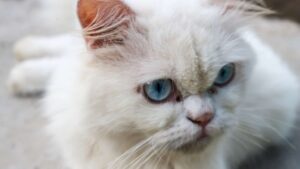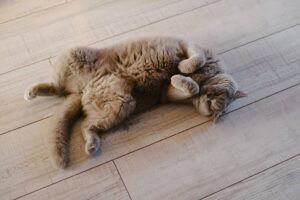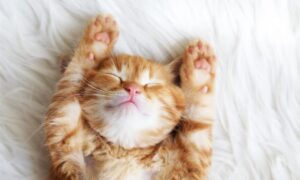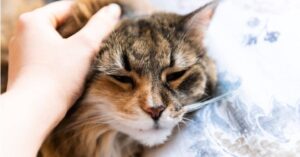Why Do Cats Wag Their Tails While Lying Down? Unraveling the Feline Mystery
Have you ever caught your cat leisurely lounging, yet its tail seems to have a mind of its own, swaying in rhythmic patterns? It’s a puzzling sight for many cat owners. The enigma of why cats wag their tails while lying down unveils a fascinating world of feline communication and emotions.
In this exploration, we delve into the intricacies of our beloved feline friends’ behaviour, demystifying the reasons behind this peculiar tail movement. From subtle expressions of contentment to potential signals of distress, understanding your cat’s tail language is essential for a deeper connection.
Join us on a journey through 10 surprising revelations, each shedding light on why your cat’s tail may sway even when at rest. Uncover the secrets behind this mysterious behavior, and gain valuable insights into the inner workings of your feline companion. Get ready to decode the silent language of tails and enhance your bond with your whiskered companion!
The 10 Possible Reasons “Why Do Cats Wag Their Tails While Lying Down?”
1. Chilling Out: Understanding the Relaxation Signals in Your Cat’s Tail Movements

why do cats wag their tails while lying down?
Witnessing your cat curled up at your feet or lounging in their favourite spot is a joy for any responsible cat owner. During these moments, you might notice a gentle swishing of their tail—a subtle yet significant behaviour. In the context of chilling out, this tail movement is a positive sign that your feline companion is in a state of relaxation and contentment.
When your cat is leisurely moving its tail while lying down, it’s an indication that they are in a good mood. The slow swishing suggests a sense of ease and comfort, expressing their satisfaction with their current environment. Whether they’re nestled by your side or settled in their preferred spot, this tail movement signifies a genuine state of feline happiness.
Moreover, you might observe your cat lazily moving their tail while receiving affection through petting or scratching. In these moments, the tail’s gentle sway reflects not only their enjoyment of the physical contact but also their overall positive disposition.
Understanding these nuances in your cat’s tail language during moments of relaxation enhances the bond between you and your furry friend. Recognizing the signs of contentment adds depth to the joy of being a cat owner, creating a harmonious environment for both you and your cherished pet.
2. In the Mood to Play: Decoding Your Cat’s Invitation to Fun

why do cats wag their tails while lying down?
Picture this: Your cat lying on its stomach, tail wagging, poised like a miniature tiger ready to pounce. The rhythmic swishing of their tail, occasionally tapping the floor, is a playful prelude to a burst of energy. In these moments, your feline friend is sending a clear message—it’s playtime!
When a cat’s tail is in fast swishing mode while lying down, it’s a playful indication that they crave interactive fun with their favourite human. The enthusiastic tail movements are a mischievous invitation, signalling their desire for engagement and shared amusement.
As the tail smacks against the floor, your cat may swiftly jump onto your foot or find a spot on your lap, interrupting whatever you’re engrossed in. Their language is straightforward: pause and indulge in a playful session. Cats exhibit this behaviour to initiate bonding and enjoyment, showcasing their social and affectionate nature.
Understanding your cat’s invitation to play not only strengthens your bond but also ensures that you cater to their need for mental and physical stimulation. So, when you see that tail swishing with excitement, heed the call—your feline companion is ready for some delightful playtime interaction.
3. In a Foul Mood: Understanding Your Cat’s “Do Not Disturb” Signal

why do cats wag their tails while lying down?
Just like humans, cats have their share of bad days, and it’s crucial to recognize when your feline friend is in a foul mood. If you notice your cat lying down with their tail moving back and forth in an agitated manner, consider it akin to a clear “do not disturb” sign.
When a cat’s tail exhibits this agitated swishing while at rest, it’s indicative of their desire for solitude. In these moments, your cat may not be in the mood for petting, playing, or any form of interaction. Attempts to cheer them up might be met with indifference, and it’s best to respect their space and leave them alone until they’re ready to socialize again.
Understanding the nuances of your cat’s tail language in these instances is essential for fostering a harmonious relationship. By recognizing when your cat needs some time to themselves, you ensure a stress-free environment for your feline companion.
So, when the tail signals a “do not disturb” mood, give your cat the space they need to reset and return to their usual cheerful self.
4. Doesn’t Feel Well: Deciphering Your Cat’s Discomfort Through Tail Movements

why do cats wag their tails while lying down?
Cats are masters at concealing physical distress, a behavior deeply ingrained in their instincts. Broadcasting weakness or vulnerability could attract larger animals, and so, your feline friend may not overtly display signs of discomfort. However, understanding their tail movements can provide valuable insights into their well-being.
If you observe sudden or unintentional tail movements in your cat while lying down, it’s akin to a feline wince—a subtle indication that something might be amiss. Much like how humans wince in response to unexpected pain, cats may express their discomfort through these unexpected tail gestures.
Decoding these signals is crucial in identifying potential health issues. If your cat exhibits strange tail movements that seem unrelated to their surroundings or activities, it may be an indication that they are not feeling well. In such cases, consider consulting a veterinarian to diagnose the underlying cause and ensure your cat receives the necessary care.
Being attuned to your cat’s subtle cues, especially through their tail language, is a proactive way to safeguard their health and well-being. So, when unusual tail movements become apparent, it’s a cue to prioritize your feline companion’s health and seek professional advice.
5. Dreaming: Unveiling the Mysterious World of Cat Naps

why do cats wag their tails while lying down?
Few things rival the sheer cuteness of a sleeping cat, and research tells us that our feline friends do experience REM (rapid eye movement) sleep—the phase associated with dreaming. Observing a cat’s tail twitching or their paws moving while in a deep slumber is not uncommon, and it provides a fascinating glimpse into the enigmatic world of feline dreams.
In the 1950s, a study offered intriguing insights into cat dreaming. Researchers severed some nerves in the brains of cats, and during observation, these cats appeared to act out their dreams. Movements in their paws and tails mirrored the motions of their waking hours, suggesting a vivid dream state.
While the content of these dreams remains a mystery due to the lack of feline conversation, it’s enchanting to think that our cats might be experiencing their own nocturnal adventures.
So, when you catch your cat moving its tail while peacefully asleep, there’s a good chance they’re immersed in a dreamland. Perhaps they’re reenacting playful moments or, who knows, dreaming about their beloved human. The whimsical world of cat naps unveils a delightful layer to our feline companions, making those sleepy tail movements all the more endearing.
6. Marking Its Territory: Deciphering Your Cat’s Tail Signals

why do cats wag their tails while lying down?
Cats are renowned for their strong sense of ownership, claiming specific spaces, objects, and even people by marking them with pheromones. These scent-laden molecules convey crucial information, not just to your cat but also to other feline friends in the vicinity. When you spot your cat lying down and gently wagging its tail, it’s likely engaging in a behavior aimed at spreading these vital pheromones.
Cat pheromones are produced in various areas, including their faces, chests, paws, and yes, their rear ends. By swaying their tails, cats effectively disperse these scent markers, creating a personalized aromatic ambiance in their surroundings. This unique method of marking serves a dual purpose: it reinforces your cat’s sense of ownership and communicates specific signals to other cats.
The act of spreading pheromones through tail movements helps your cat feel secure and comfortable in its environment. It’s a natural instinct that aids in establishing territory boundaries and fostering a sense of familiarity. Understanding this aspect of your cat’s behavior provides valuable insights into their need for a well-defined and marked-out space.
So, the next time you witness your cat’s tail in action, recognize it as a deliberate act of claiming and communicating within their feline world.
7. Staying Balanced: The Tail’s Role in Your Cat’s Resting Rituals

why do cats wag their tails while lying down?
Whether cats are scaling heights or navigating precarious surfaces, their tails play a pivotal role in maintaining balance and control. This isn’t exclusive to active moments; even when cats lie down, their tails continue to serve a crucial purpose in ensuring equilibrium.
When your cat is in a state of repose, vulnerability becomes inherent. In response to this, you might observe your feline friend sticking its tail in the air, gently swaying it to and fro. This seemingly subtle action is an intricate part of their instinctual behavior to stay balanced, even in moments of relaxation.
The slight movement of the tail while lying down is a strategic measure to sustain equilibrium. It’s a way for your cat to stay poised and ready, maintaining awareness of their surroundings. This readiness is essential as it ensures they can swiftly spring into action if the need arises, aligning with their innate instinct for self-preservation.
Understanding this aspect of your cat’s behavior adds another layer to the fascinating world of feline habits. The tail’s role in maintaining balance during repose showcases the intricate adaptations that make cats the graceful and agile creatures we adore.
8. On Guard: Deciphering Your Cat’s Watchful Tail Movements

why do cats wag their tails while lying down?
Even in moments of repose, your cat maintains the regal demeanor of a master surveying its kingdom. There are times, however, when their environment takes on a different vibe—more people, louder sounds, increased movement. In response to this altered atmosphere, your cat may exhibit a subtle yet significant behavior: moving its tail back and forth on the floor.
This tail movement serves as a telltale sign that your cat is on guard, feeling a bit nervous or skittish in response to the unfamiliar surroundings. While there might not be a direct sense of imminent danger, your feline companion wants to stay vigilant, keeping a watchful eye on the unfolding events.
Understanding this behavior is crucial for a responsible cat owner. If you observe your cat’s tail signaling unease, consider relocating them to a quieter area. Creating a calm environment allows your cat to regain their sense of security, promoting their well-being.
In decoding the language of your cat’s tail, you forge a deeper connection with your feline friend. Recognizing when they are on guard and taking proactive steps to alleviate their discomfort fosters a harmonious relationship, ensuring your cat feels safe and at ease in their domain.
9. Afraid: Unraveling Your Cat’s Tail Language in Moments of Fear

why do cats wag their tails while lying down?
In times of sudden fright, our minds often conjure images of cats arching their backs and raising their tails in a display of startlement. However, fear in felines isn’t limited to upright gestures—it can manifest even when your cat is lying down, subtly attempting to conceal their distress.
When scared, cats may adopt a defensive posture while lying down, striving to minimize attention. They might appear smaller, wrapping their tails around themselves as a protective measure. While some tail movement may persist, it tends to be subdued, reflecting the cat’s attempt to navigate the situation without drawing undue notice.
In more extreme cases of fright, you might observe your cat maneuvering its tail between its legs—an instinctive response to perceived danger. Understanding these subtle cues is pivotal for a cat owner, allowing you to provide reassurance and a sense of security to your feline companion.
Deciphering your cat’s tail language in moments of fear not only deepens your connection but also aids in creating a supportive environment. Recognizing their distress signals and responding with care ensures that your cat feels safe and protected, even in the face of unexpected scares.
10. Enjoying Your Attention: Decoding Your Cat’s Response to Affection

why do cats wag their tails while lying down?
The irresistible allure of a lying-down cat often prompts cat owners to indulge in a session of gentle petting. After all,
they’re just too adorable to resist! As your cat is already in a state of relaxation, there’s a high likelihood they’ll welcome the unexpected interaction.
It’s a common sight for cats to express their enjoyment by thumping their tails against the floor when being petted or scratched.
While basking in the joy of your cat’s affection, it’s essential to gauge their responses. As with any good thing, moderation is key. Cats can become overstimulated, signalling their readiness for the petting session to conclude. If you notice their tail wagging quickly, it’s a subtle cue that it’s time to back away and allow your cat to recalibrate their comfort level.
Understanding your cat’s communication during these moments of affection enhances the bond between you and your feline friend. It’s a delightful exchange of love and companionship, where both parties can revel in the joy of shared moments.
So, when your cat thumps its tail in response to your attention, take it as a heartwarming acknowledgement of the special connection you share.
Conclusion: Keep Your Eye on the Tail!
In unraveling the mysteries behind why cats wag their tails while lying down, we’ve embarked on a fascinating journey into the nuanced world of feline behavior. From the subtle art of claiming territory through pheromones to the intricate language of tail movements in moments of fear or relaxation, each tail flick tells a story.
When your cat is chilling out, their tail’s gentle sway is an expression of contentment and relaxation. In playful moods, that same tail becomes an invitation to engage in delightful interactions, while a tucked tail signifies potential discomfort or fear.
Understanding the significance of tail movements while your cat is lying down sheds light on their emotional state and enhances your ability to respond appropriately.Whether it’s about marking territory, staying balanced, expressing fear, or enjoying your attention, your cat’s tail is a dynamic communicator.
The key lies in paying attention to the subtle nuances and cues, allowing you to foster a deeper connection and create a harmonious environment for your feline friend. So, keep your eye on the tail—it’s your cat’s silent yet expressive guide to their ever-fascinating world!



3 comments
Wonderful website. I’m sending it to some friends and also sharing in yummy. Thanks for your work.
Well written post! This is a really fantastic post, and we will link to it on our website. Continue your fantastic writing.
I loved you better than you would ever be able to express here. The picture is beautiful, and your wording is elegant; nonetheless, you read it in a short amount of time. I believe that you ought to give it another shot in the near future. If you make sure that this trek is safe, I will most likely try to do that again and again.